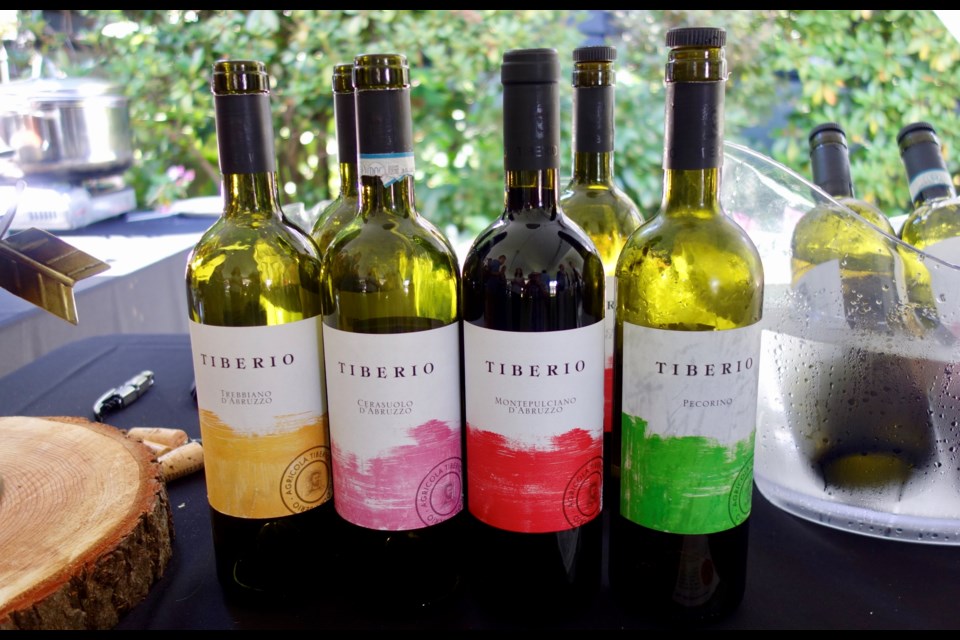Most of us think of Italy as the land of wine where winemaking has been going on for millennia. But with all that ancient tradition, many of us do not associate Italy with much innovation these days. But that certainly is far from the truth when it comes to Agricola Tiberio in the region of Abruzzo, a mountainous area east of Rome on the Adriatic Sea.
Tiberio’s winemaker, Cristiana Tiberio was in town this month at a summer extravaganza garden party, hosted by Grace Li of World Wine Synergy. Decades ago Tiberio’s father, Riccaro, discovered 60-year-old neglected Trebbiano d’Abruzzese vines in a forgotten plot. If he could resurrect these indigenous vines, they would make a far superior wine compared to the common but simple Trebbiano Toscano.
In 2000 Riccardo purchased the plot and planted a variety of indigenous grapes that could be matched to the different soils in the vineyard:, Trebbiano d’Abruzzo, Cerasuolo d’Abruzzo, Montepulciano d’Abruzzo, and Pecorino among others. By 2004, Tiberio released his inaugural vintage in 2004 to critical acclaim with mineral whites and fresh fruity reds.
Cristiana and her brother, Antonio took over the winery in 2008 with her being the winemaker and Antonio being viticulturist. Also taking on the role of being the global ambassador for the winery, she fervently believes “that you can only truly make a wine with the greatest expression of the place if you have lived there and really understand the climate and sense of the place.”
Unlike many Trebbiano’s that lack character, the Tiberio Trebbiano d’Abruzzo ($23.99) displays plenty of personality. The grapes are organically grown on limestone soil on 55-year-old vines. Old vines produce fruit with more character with a mineral flavour to add complexity. And the wine is wild fermented, unfiltered, aged, and stored in stainless steel. There is no oak to interfere with the fruits natural aromas and flavours.
Expect a medium-light wine with aromas of pineapple, lemon peel, honey, and herbs. The flavours of apples, pears, almonds are refreshing with good acidity and a medium light body. A feast of seafood or white meats would pair perfectly. Because of the natural acidity, fried foods work well too. Delicious on a summer’s day!
Switching to rosé, the 2017 and 2018 Tiberio Cerasuolo D’Abruzzo ($23.99) is made from Montepulciano red grapes, hand harvested on the estate from half century-old vines. Unlike many vineyards that have one clone of a grape variety, the vineyard has a wide variety of clones to add complexity to the wine.
Normally rosés should be drunk immediately, but the Cerasuolo d’Abruzzo can improve with a year or two of cellaring. Yet, it is delicious today to enjoy as a sipper or when dining.
It has a generous fruity nose of cherries, raspberries and hints of cinnamon. The juicy flavour tastes of rich red fruit, with a tartness that makes this wine refreshing when you chill it for an hour.
There are also gentle tannins that give this rosémore body and structure than you’d expect. And the tannins make it a great food wine with a variety of dishes, including grilled Italian sausages, salad Nicoise with tuna, or grilled eggplant and zucchini.
Like all their wines, the Tiberio 2016 Montepulciano d’Abruzzo ($25.99) delivers more than you expect. This bright dark ruby red displays generous aromas of sour cherries, raspberries, plums, minerals, and aromatic spices. With smooth tannins, elegant fruit, lively acidity, and a juicy finish, enjoy with steaks, tomato and meat pasta dishes, venison, and cheese.
All three Tiberio wines are available at government stores.



